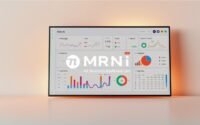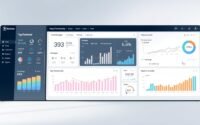Affordable Business Software: MRN AI Smart Dashboard
What if one simple hub could stop app juggling and actually save you time and money?
If you’re a small owner tired of switching tabs, this guide is for you. We’ll show how the MRN AI Smart Business Dashboard brings daily admin into a single, clear place so teams can cut errors and reclaim hours each month.
Studies show automation can cut operational costs up to 30% and slash manual mistakes. That means faster invoicing, cleaner books, and more time for growth.
This platform unifies common tools like scheduling, invoicing, and document handling so owners see real ROI fast. Expect plain, practical advice, real numbers, and a simple playbook to get started without a long learning curve.
Key Takeaways
- One unified hub reduces app sprawl and saves time.
- Automation can lower costs and cut manual errors significantly.
- Small teams gain clarity with real-time views of operations.
- Setup is designed to be quick and friendly for non-technical users.
- We’ll map features to practical use cases and a simple adoption plan.
Searching for affordable AI tools? Here’s why this dashboard nails your intent right now
If every minute and dollar counts, a consolidated hub turns scattered tasks into clear, fast outcomes. Small teams get practical wins without long rollouts.
Instant value for small business owners on tight budgets
This platform bundles scheduling, invoicing, and document handling so you stop paying for overlapping apps. That means you reclaim time and avoid subscription sprawl.
Proof points: time savings, error reduction, and fast ROI
Real numbers matter. Companies using automated admin report up to 30% cost savings and up to 90% fewer manual errors. SMBs often reclaim about 55 hours per month by automating bookkeeping, invoicing, and reporting.
With 82% of early adopters seeing ROI in year one, a unified approach delivers quick payback. If you want a simple, powerful set of features that reduce wasted minutes and improve accuracy, this is built for you.
Ready to stop juggling and start saving? Try it now and see results fast: https://businessgoeslocal.com/MRN-AI-Smart-Business-Dashboard
Meet MRN AI Smart Business Dashboard: the simple, powerful hub for small businesses
Small teams win when their admin, reporting, and daily ops live in one easy hub. This platform puts admin, reporting, and everyday operations under one roof so owners stop switching tabs and start making moves.
What it centralizes: admin, reporting, and day-to-day operations
The platform acts as your command center. It brings scheduling, invoicing visibility, document organization, and quick reporting into a single, easy interface.
Designed for non-technical teams, the tool uses templates and clear menus so anyone can set up workflows without a specialist. That reduces context switching and hidden costs.
Real-time reporting gives instant clarity on cash flow, pipeline status, and task progress. Flexible access controls mean owners see the whole picture while team members get only what they need.
Get started with MRN now
Ready to run your day from one hub? Try the platform and feel the difference: https://businessgoeslocal.com/MRN-AI-Smart-Business-Dashboard
MRN AI Smart Business Dashboard low-cost business software
Tiered pricing means you can start lean and scale costs as your work grows.
Choose from clear plans and flexible options that match your stage and budgets. Each plan bundles common features so you don’t pay for extras until you need them.
Stacking many apps can feel cheap at first, but subscription fees add up and create admin headaches. Consolidating into one tool reduces vendor fees and cuts maintenance time.
How costs compare
- Tiered plans: pick the level that fits current needs and upgrade as you grow.
- Fewer apps: consolidate invoicing, scheduling, and docs into a single footprint.
- Staffing vs. software: automated workflows handle routine tasks at a fraction of hiring costs, often reducing operational expenses by up to 30%.
Built-in support helps teams hit early milestones fast, shortening payback time and easing transitions. Explore the current plans and pick what fits today: https://businessgoeslocal.com/MRN-AI-Smart-Business-Dashboard.
E.E.A.T. perspective: choosing reliable, budget-friendly AI that scales
For companies balancing tight budgets and growth goals, reliability and support matter most.
Expertise: The platform is built around real small‑team workflows professionals use daily. That means practical outcomes instead of flashy extras you’ll ignore.
Experience & authority: Today, 95% of U.S. companies use automation to work more efficiently, and 82% of early adopters report positive ROI within a year. McKinsey notes workflow redesign yields large EBIT gains, underscoring why thoughtful implementation pays off.
Trust & accuracy: Reducing manual entry and standardizing processes cuts errors. Clear versioning, approval steps, and audit trails help owners and entrepreneurs keep reports reliable.
Support matters: Guided onboarding and responsive support help a company adopt best practices without hiring extra staff. That preserves budget and speeds results.
| Focus | What it delivers | Why it matters |
|---|---|---|
| Expertise | Workflows tuned for SMB needs | Saves time and reduces setup friction |
| Accuracy | Standardized entries and audit logs | Fewer errors, cleaner reporting |
| Support | Onboarding and ongoing help | Faster adoption, sustained ROI |
| Scalability | Add workflows and users easily | Grows with your processes without chaos |
Confidence: If you want dependable tools that scale with care, choose solutions built for small companies and guided by real support. Try it and see steady gains.
Core features that replace repetitive tasks and manual data entry
Replace time‑sapping chores with automated flows that run reliably in the background.
Automation covers scheduling, invoicing, and document handling so teams stop repeating the same steps every day.
Automation for scheduling, invoicing, and document organization
Set up calendar flows with reminders and confirmations to cut no‑shows and reduce back‑and‑forth emails.
- Automate the repetitive tasks that drain energy — scheduling, invoice creation, and follow‑ups.
- Replace manual data entry with smart capture and categorization to avoid missed details.
- Keep documents labeled, versioned, and searchable so contracts and receipts are easy to find.
Real-time insights and reporting to guide decisions
Clean reports and live insights show what needs attention now. You’ll see cash flow, open invoices, and workload at a glance.
| Feature | What it saves | Why it helps |
|---|---|---|
| Scheduling automation | Hours per month | Fewer no‑shows and less email |
| Invoicing flows | Errors & collections time | Faster payments, cleaner records |
| Document management | Search time | Quicker access, fewer mistakes |
Because everything rolls into a single management view, you stop piecing status from many places. Smarter reports and clear insights let you act on facts, not guesses.
See the dashboard in action — https://businessgoeslocal.com/MRN-AI-Smart-Business-Dashboard
How MRN reduces errors and boosts accuracy across operations
When data enters your systems the same way every time, errors drop fast. Standardized forms and required fields stop accidental omissions. That means fewer late invoices and cleaner ledgers.
From bookkeeping to content and communication — fewer mistakes, better outcomes
In bookkeeping and invoicing, reducing manual touchpoints leads to more reliable cash flow forecasting. Automated captures and reconciliations cut typical manual errors by up to 90%, delivering trustworthy reports in real time.
For content and communications, templates plus approval steps keep messaging consistent. That lowers misfires with customers and preserves brand quality across channels.
- Standardized data entry reduces “oops” moments and speeds month-end.
- Structured workflows make management simpler for small teams on busy days.
- Cleaner data powers better decisions, fewer disputes, and smoother audits.
The result: dependable outcomes across daily operations. With fewer errors to fix, teams spend more time growing the business and less time chasing clarifications.
Where MRN fits in a modern AI stack for small businesses
A central management layer helps your favorite tools work together without extra fuss. This platform sits at the center of your stack and unifies data from chatbots, schedulers, marketing automation, and other systems.
Keep what works, unify the rest. Pair the hub with chatbots for 24/7 lead capture, scheduling apps for smooth bookings, and marketing solutions for segmented campaigns. Transcription and CRM tools keep feeding one clear timeline.
Integrations stop double entry and give owners a single view of activity, tasks, and outcomes. That reduces swivel‑chair work and keeps teams aligned as the company grows.
- Center of operations: The platform connects popular tools so each app can focus on what it does best.
- Flexible fit: Add, swap, or keep apps without tearing up workflows.
- Clear oversight: One management layer gives transparency across the business.
Non‑technical teams get plug‑and‑play integrations that speed adoption. The result: specialty tools shine, and the platform coordinates the bigger picture so small businesses run like larger teams—without the overhead.
Small team, big output: do more with the same people
When daily handoffs are automated and tracked, a handful of people can deliver far more work without burnout.
That shift turns routine admin into predictable flows. Fewer status pings and clearer responsibilities free up real time for focused tasks.
For many small businesses, this is a capacity game, not a hiring one. With proven workflow redesign, teams report dozens of hours saved each month and faster project delivery.

- Force multiplier: Orchestrates task flow so one team can do work that once needed more heads.
- Less friction: Fewer meetings, fewer back‑and‑forths, and smoother handoffs.
- Visible progress: One source of truth speeds responses and tightens cash cycles.
Over time, saved hours become shipped projects, quicker replies to customers, and stronger results for the business. Less firefighting, more focused output — that’s how small businesses keep pace with larger rivals.
Prioritizing time: automate the admin, focus on growth
Time is the currency every owner spends; automating admin buys you interest in future growth. Small teams report reclaiming about 55 hours per month when they automate bookkeeping, invoicing, scheduling, and reporting.
That reclaimed time becomes fuel for real work: planning new offers, improving customer experience, and building partnerships that grow revenue.
A simple platform handles repetitive tasks and simplifies daily management. When routine work runs itself, priorities get clearer. You stop guessing what matters today and start acting on what moves the needle.
- Reclaim hours: Turn daily chores into predictable flows so staff focus on strategy.
- Better planning: Use saved cycles for quarterly planning instead of weekly firefights.
- Repeatable routine: A calm, structured approach scales as the business grows.
“Small operational wins compound. A few hours saved weekly becomes meaningful progress by quarter-end.”
Owners gain breathing room to be proactive. Protecting your most scarce resource—time—is the practical path to scaling. Let the system handle admin so your team builds the future of the business.
From setup to first wins: a simple adoption playbook
Start small, aim for quick wins, and build confidence across the whole team.
Quick-start onboarding should be practical and calm. Begin with a 60-minute setup session to define core workflows: scheduling, invoicing, and document storage. Create one simple template for each and invite the core staff.
Quick-start onboarding and training tips for non-technical teams
Keep the interface tidy. Enable only essential modules at first so people learn one flow at a time.
- Run 20-minute role-based training bursts that show real examples.
- Pick one or two high-friction processes to redesign and aim for a first win within a week.
- Assign a “dashboard captain” to field questions and keep momentum.
Change management: ramp without disrupting daily work
Set a daily 10-minute check: review tasks, confirm priorities, and log blockers. This small ritual saves lots of time and keeps team focus tight.
Lean on support early. Their guidance prevents overcomplication and speeds a calm rollout. Communicate the “why” clearly and ask for feedback as you iterate.
“Aim for a first, measurable win in week one to build trust and keep adoption moving.”
| Step | Action | Goal (30 days) |
|---|---|---|
| Setup | 60-minute define & invite | Core workflows active |
| Training | 20-minute role sessions | Confident daily users |
| Early wins | Fix 1–2 high-friction tasks | Visible time saved |
| Ongoing | Daily check & captain | Steady adoption |
Measure and celebrate. Track weekly time saved, share wins, and by month one you should see fewer scattered updates, faster execution, and clearer ownership across the business.
Security and reliability without the enterprise price tag
You don’t need a big IT team to get solid protection for your daily workflows and documents.
Expectations for small companies: modern systems include encryption in transit and at rest, role-based access, and audit-ready logs. These features help meet common compliance needs such as GDPR or HIPAA where applicable.
Secure-by-default design means less maintenance for your team. Cloud-first hosting keeps availability high and reduces the overhead of on‑prem hardware.
Practical safeguards: permissioned access ensures the right people see the right files. Audit trails and consistent workflows make it easier to show control during reviews.
Support is part of the package. Staffed help guides you through sensible access settings and trains your team on safe habits.
- Everyday reliability without corporations-level complexity.
- Right-sized controls that match your company needs.
- Focus on uptime plus predictable processes to avoid surprises.
“Peace of mind is not about expensive gear; it’s about sensible controls, clear access rules, and support you can use.”
Use cases by role: owners, operators, and professionals
When each person sees what matters to their job, execution gets faster and calmer.
Owners and entrepreneurs: oversight without spreadsheet chaos
Owners get a clean view of cash flow, key tasks, and blockers in one place.

Operations and admin: fewer repetitive tasks, clearer workflows
Operations and admin teams cut repetitive tasks with automation.
Handoffs become smoother, steps repeat reliably, and missed actions drop.
Finance-minded users: budgets, reports, and trend tracking
Finance staff see simple budgets, clear reports, and trend lines to spot issues early.
Shared visibility reduces back-and-forth and speeds month-end close.
- Role-based management views focus each person on what matters most.
- Professionals who need reliable process guardrails get consistent execution without heavy oversight.
- The result: clearer priorities, fewer errors, and better collaboration across the business.
“When everyone can trust the same data, teamwork improves almost automatically.”
Value vs. costs: why a unified dashboard beats app sprawl
Replacing scattered tools with one hub reduces monthly fees and clears the clutter that slows teams down. A single platform can replace multiple subscriptions for scheduling, invoicing, document storage, and reporting.
Consolidation cuts complexity and gives you better insights because data no longer sits in separate places. When everything speaks the same language, reports become reliable and decisions are faster.
Consolidation savings: fewer subscriptions, stronger insights
- App sprawl is expensive and confusing — one dashboard shows the whole picture so you act on facts, not fragments.
- You’ll likely drop multiple subscriptions when the platform covers scheduling, invoicing flows, document organization, and reporting.
- Fewer vendors free budget for growth initiatives instead of administrative overhead.
- Plans and options scale with your stage, so you only pay for extra seats or features when you need them.
- With a single software footprint, onboarding is faster and governance is simpler, reducing shadow tools and risk.
The savings aren’t just dollars: they are time, clarity, and fewer headaches. Choose a plan that replaces the many tools you use today, and let simpler solutions deliver stronger results for your business.
“Consolidation improves clarity — fewer subscriptions, clearer reporting, and faster decisions.”
Comparing categories: where MRN stands out among AI tools for SMBs
One well‑connected hub makes specialized tools sing together instead of competing for attention. Small teams often keep favorite marketing and inventory systems, but they need a central place to coordinate tasks, approvals, and content handoffs. A single platform reduces duplicate work and speeds launches without ripping out systems that already work.
Marketing, HR, docs, transcription, and inventory — filling the gaps with one hub
Marketing: Continue using Mailchimp or HubSpot while tracking campaign tasks, approvals, and creative assets inside the hub for smoother launches.
HR basics: Run onboarding checklists, recurring reviews, and policy access from one place so nothing slips through the cracks.
Documents: Centralize contracts and SOPs with version history and fast retrieval so the right file is always available.
Transcription: Plug in services like Otter to capture meeting notes, then push action items into task flows automatically.
Inventory: Mirror key updates from a dedicated inventory tool so operations see stock changes without jumping between apps.
- Features tie categories together so each specialty tool does its job while the hub manages coordination.
- This approach cuts confusion, prevents duplicate effort, and keeps timelines moving.
- You gain control over the lifecycle from ideation to execution to reporting without micromanaging teams.
CTA: Try MRN today and streamline your stack
Ready to streamline your stack? Try the platform now and let one hub coordinate your tools, content, and workflows: https://businessgoeslocal.com/MRN-AI-Smart-Business-Dashboard
Real-world momentum: AI adoption and ROI trends small businesses can leverage
Momentum is shifting: practical automation tools are moving from experiments to everyday operations in many startups.
Recent studies show 95% of U.S. companies use automation for efficiency, and early adopters typically see positive ROI within year one. For small businesses, that means real gains in a short time.
Doing more with less: how automation levels the playing field for small teams
Entrepreneurs and owners reclaim roughly 55 hours per month by automating invoicing, scheduling, and reporting. That recovered time funds growth work instead of routine fixes.
- The current trend: automation is now core, not optional, for startups and small businesses.
- When your data is live and visible, you react faster and compete with larger players.
- Workflow redesign delivers the biggest EBIT lift — align processes, and wins compound quickly.
“The earlier you implement, the sooner you benefit.” Choose a practical platform that gives fast, reliable wins so your team spends less time on admin and more on moving the business forward.
Conclusion
Cutting admin friction is the quickest way for business owners to free hours for growth. If you run a small business, a single hub that centralizes everyday work reduces errors and speeds decisions.
This platform lets non-technical teams onboard fast, keep existing apps, and get early wins from redesigned workflows. It is a practical tool that centralizes content, scheduling, and invoicing so routine tasks stop stealing time.
MRN is the practical platform that fits your stage and budget. Try it now and capture quick wins: https://businessgoeslocal.com/MRN-AI-Smart-Business-Dashboard. Choose a plan, onboard the team, and let the system handle routine work while you focus on the future.
FAQ
What is the affordable business software featured in the briefs?
The briefs describe a cost-conscious dashboard designed for small business owners and entrepreneurs. It centralizes administrative tasks, reporting, and day-to-day operations so teams can reduce repetitive tasks and manual data entry while gaining real-time insights.
How does this tool deliver instant value for small businesses on tight budgets?
By consolidating multiple functions—scheduling, invoicing, document organization, reporting—into one platform, it cuts subscription costs and saves time. That reduces errors, speeds workflow, and helps owners see a faster return on their investment compared with hiring extra staff or stacking many point apps.
What measurable proof points should I expect—time savings, error reduction, ROI?
Typical outcomes include fewer hours spent on admin, lower data-entry mistakes in finance and operations, and clearer trend reporting for smarter decisions. These gains translate into quicker ROI through labor savings and fewer costly errors.
What core features replace repetitive tasks and manual data entry?
Key features include automation for scheduling and invoicing, document organization and templates, integrations with common apps, and automated reporting. These tools reduce manual steps and free staff to focus on revenue-generating work.
Can this platform integrate with my existing chatbots, scheduling tools, or marketing apps?
Yes. The dashboard is designed to pair with common tools so you can keep systems that already work and unify data where it helps most. Integrations let you streamline workflows without a full rip-and-replace.
What plan options and support can small teams expect?
Plans typically scale by feature set and seats, with options for basic workflows up to full reporting and integrations. Support often includes onboarding, online resources, and tiered customer service to help non-technical teams ramp quickly.
How steep is the learning curve for non-technical staff?
Onboarding focuses on quick-start setup and role-based training. Small teams usually see first wins within days, thanks to guided walkthroughs and templated workflows that minimize disruption to daily work.
How does the dashboard improve accuracy in finance and operations?
It reduces manual data entry, applies consistent templates and rules, and consolidates records for clean bookkeeping and reporting. That leads to fewer reconciliation errors and clearer budget and trend tracking.
Where does this solution fit in a modern tech stack for small businesses?
It serves as a unifying hub that complements point solutions—handling central admin, reporting, and automations while leaving specialized tools in place for niche tasks like advanced marketing or payroll.
Will it help small teams produce more with the same headcount?
Yes. By automating routine admin and streamlining workflows, teams can redirect time to strategic tasks. That boosts output without immediate hires and improves operational efficiency.
What security and reliability can small businesses expect without enterprise costs?
The platform emphasizes secure data handling, role-based access, and regular backups while offering affordable service tiers. That balances enterprise-grade practices with pricing suitable for startups and small firms.
How does choosing a unified dashboard compare with using many separate apps?
Consolidation cuts subscription costs, reduces data silos, and delivers stronger insights from combined reporting. It also lowers the time spent toggling between systems and reduces integration headaches.
Which roles benefit most from this dashboard—owners, operators, finance teams?
Owners gain oversight without spreadsheet chaos, operators get clearer workflows and fewer repetitive tasks, and finance users receive streamlined budgets, reports, and trend analysis to support decisions.
What steps should we follow from setup to first wins?
Start with core workflows—bookkeeping, invoicing, scheduling—map current processes, enable automations, and train users on role-specific tasks. Measure time saved and iterate to expand automations and integrations.
Are there common use cases by industry or team size?
Yes. Small retailers, service providers, agencies, and nonprofits use the platform for appointment scheduling, invoicing, inventory checks, client communication, and consolidated reporting—delivering quick operational gains.
How do I evaluate value versus cost when choosing this kind of tool?
Compare total subscription spend and time saved against the cost of hiring or maintaining multiple apps. Factor in reduced error-related expenses and improved cash flow visibility to see the full value picture.
Does the platform offer demos or trials so I can see it in action?
Most vendors provide live demos and trial periods so you can test integrations and workflows with your team before committing. Use a short pilot to confirm fit and measure initial ROI.


